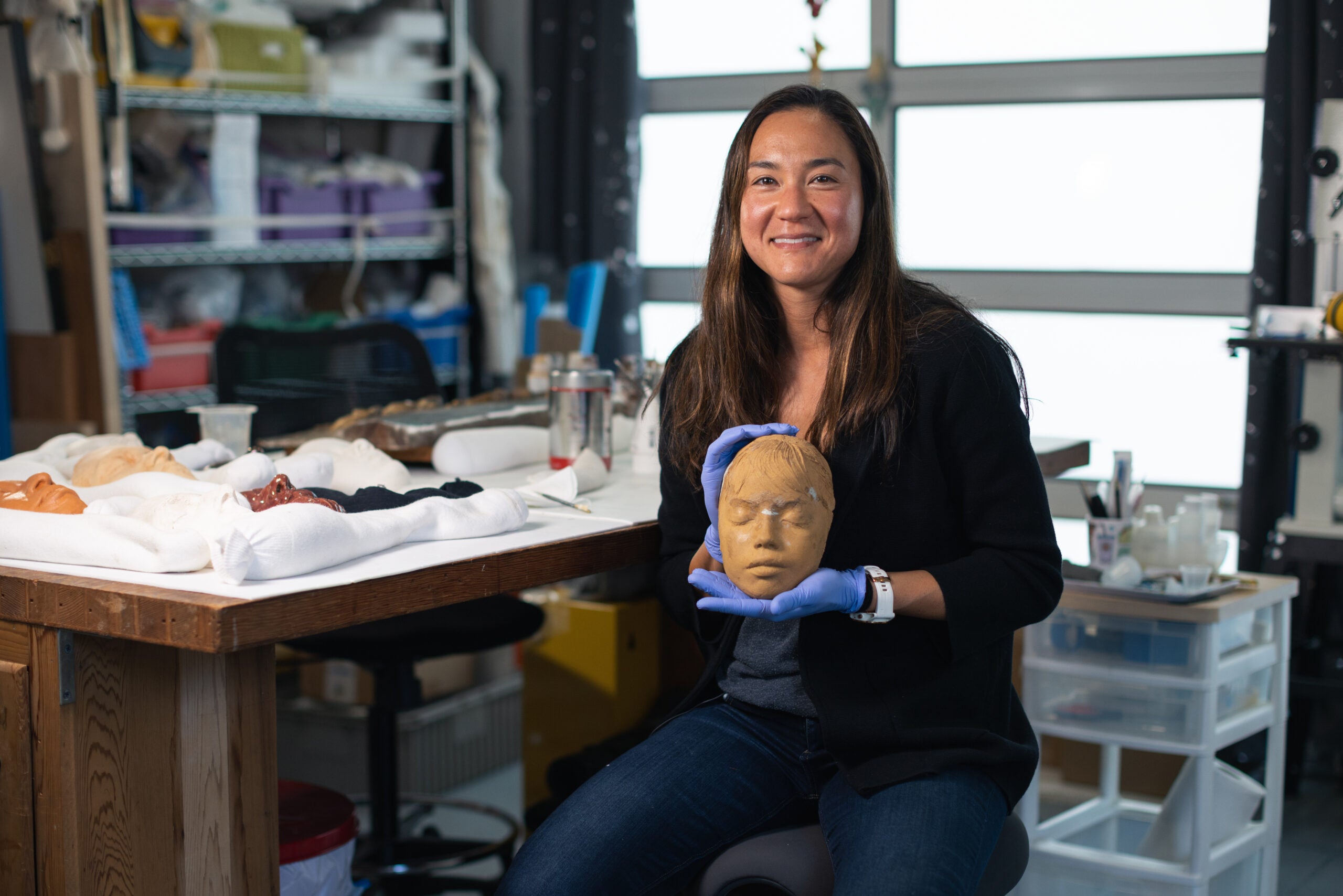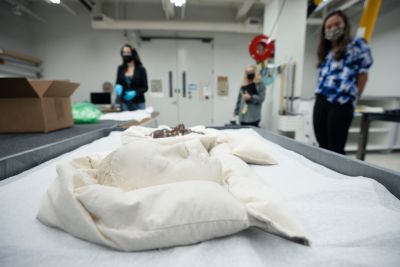For decades, hundreds of masks created by the sculptor Ruth Asawa of her friends and family hung on the garden wall of the artist’s San Francisco home in the Noe Valley neighborhood. The majority of that collection is now on display at the Cantor Arts Center, on view to the public for the first time. This significant acquisition and installation, titled The Faces of Ruth Asawa, is part of Stanford’s Asian American Art Initiative.
The masks’ journey from San Francisco to the Cantor began in 2019, when Asawa’s daughter and son-in-law, Aiko and Laurence Cuneo, came to the Cantor to help oversee the installation of one of Asawa’s abstract wire sculptures. Aleesa Pitchamarn Alexander, the Cantor’s assistant curator of American art, had chosen the piece for rotation in the exhibition The Medium Is the Message: Art Since 1950. During installation, Aiko asked Alexander if she knew about the masks.

Image credit: Andrew Brodhead

Image credit: Andrew Brodhead

Image credit: Andrew Brodhead

Image credit: Andrew Brodhead

Image credit: Andrew Brodhead

Image credit: Andrew Brodhead

Image credit: Andrew Brodhead

Image credit: Andrew Brodhead

Image credit: Andrew Brodhead

Image credit: Andrew Brodhead

Image credit: Andrew Brodhead

Image credit: Andrew Brodhead

Image credit: Andrew Brodhead
“Though I had been an admirer of Asawa’s work for a long time,” Alexander said, “I had never heard of these masks or her ceramic work. Once Aiko and Laurence showed me some pictures, I was amazed. These masks, cast from the faces of friends and family, completely expanded my understanding of Asawa’s practice. It underscored to me how essential community engagement was to her world and artistic output.”
In the ensuing months, Alexander continued the conversation about the masks with the estate of Ruth Asawa, who died in 2013. The masks had long been considered ephemera rather than an official part of the work of the artist, who is known primarily for her modernist abstract wire sculpture. But it was becoming increasingly clear that these objects were major works that contributed to a fuller, more complete understanding of Asawa’s life.
During this time, the Cantor was preparing to launch the Asian American Art Initiative (AAAI), which has since transformed Stanford into the leading academic and curatorial center for Asian American art. Part of the initiative involves the Cantor seeking to build the preeminent collection of Asian American art at a university art museum. Asawa’s 233 ceramic masks had found their permanent home.
Franz Kunst, processing archivist in Stanford Libraries Department of Special Collections, which houses Asawa’s publicly accessible digital archive, said, “There is, of course, an awful lot about her mask-making in her papers, but the archive also demonstrates how wide-reaching her creative network was, and how many different people she made life masks with.”
The Cantor acquired Untitled (LC.012, Wall of Masks) in 2020, and they went on long-term view at the museum on July 6. The installation, curated by Alexander, features the masks by Asawa and three vessels made by the artist’s son Paul Lanier using clay mixed with the ashes of Asawa; her husband, Albert; and their late son, Adam. Upon Asawa’s death – per her request – Lanier threw a set of vessels incorporating this material, one for each remaining sibling. The three included in The Faces of Ruth Asawa were borrowed from the family to further demonstrate Asawa’s intimate connection to clay.
“The Faces of Ruth Asawa is a unique installation,” Alexander said. “If museum visitors are familiar with her, they likely know of her hanging biomorphic wire sculptures. This installation provides a glimpse into a different side of Asawa’s practice and a distinct view of the Bay Area arts community during the last half of the 20th century.”
The road to San Francisco
Ruth Asawa was born in Norwalk, California, in 1926 and spent the early part of her life on her parents’ farm with her six siblings. During World War II, her family was interned as part of Executive Order 9066. After graduating from high school in an incarceration camp, she attended Milwaukee State Teachers College but could not obtain a degree due to her Japanese ancestry. From 1946 to 1949, she attended the historically significant art school Black Mountain College in North Carolina. There she studied with Josef Albers and met her future husband, Albert Lanier. Asawa and Lanier moved to San Francisco, where they would remain for the rest of their lives.
Asawa continued her sculptural practice in San Francisco while also advocating for the arts. She served on the San Francisco Arts Commission, helped establish the San Francisco School of the Arts (now the Ruth Asawa San Francisco School of the Arts), and was the first artist to serve on the Board of Trustees for the Fine Arts Museums of San Francisco.
“She was a creative spirit to the highest degree, but not only that, she never forgot about the other elements that make life worth living: family, community, and the preservation of history,” said Alexander. “I hope this installation effectively captures her spirit and inspires others, as she has inspired me.”
The Asian American Art Initiative on display
Based at the Cantor, the Asian American Art Initiative is dedicated to the study of artists and makers of Asian descent. Founded and co-directed by Alexander and Marci Kwon, assistant professor of art and art history in the School of Humanities and Sciences, AAAI encompasses a range of activities, including collecting and exhibiting works of Asian American and Asian diaspora artists; preserving archival materials; supporting undergraduate and graduate education; and cultivating community involvement through public programming.
“I cannot imagine a more fitting artist to launch our robust season of AAAI exhibitions and activities this fall than Ruth Asawa,” said Veronica Roberts, newly appointed John and Jill Freidenrich Director of the Cantor. “She is so deeply admired in the Bay Area as an artist and for the impact she had as an arts education advocate. As recognition of her significance expands across the globe, we are honored to help expand public perception of her legacy.”
The Faces of Ruth Asawa is one of three installations and exhibitions related to AAAI opening at the Cantor this year. At Home/On Stage: Asian American Representation in Photography and Film opens Aug. 31, and East of the Pacific: Making Histories of Asian American Art opens Sept. 28.
Media Contacts
Robin Wander, Director of Arts Communication: (650) 724-6184, robin.wander@stanford.edu